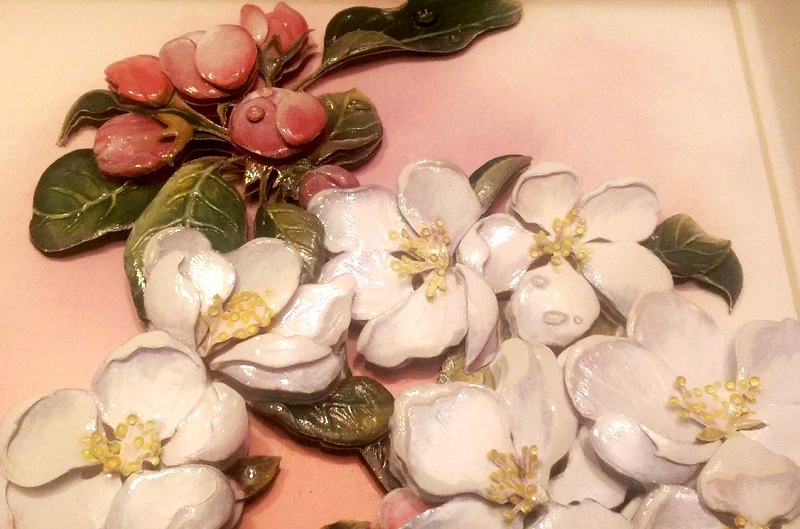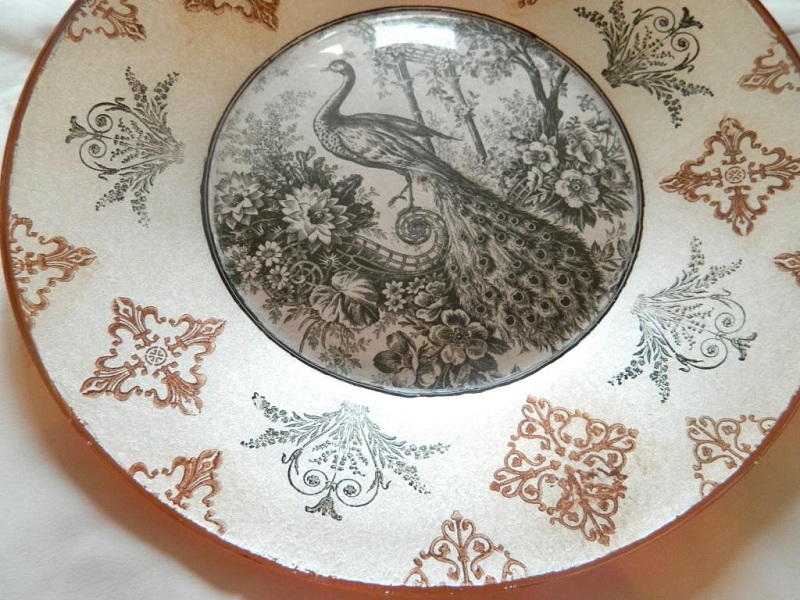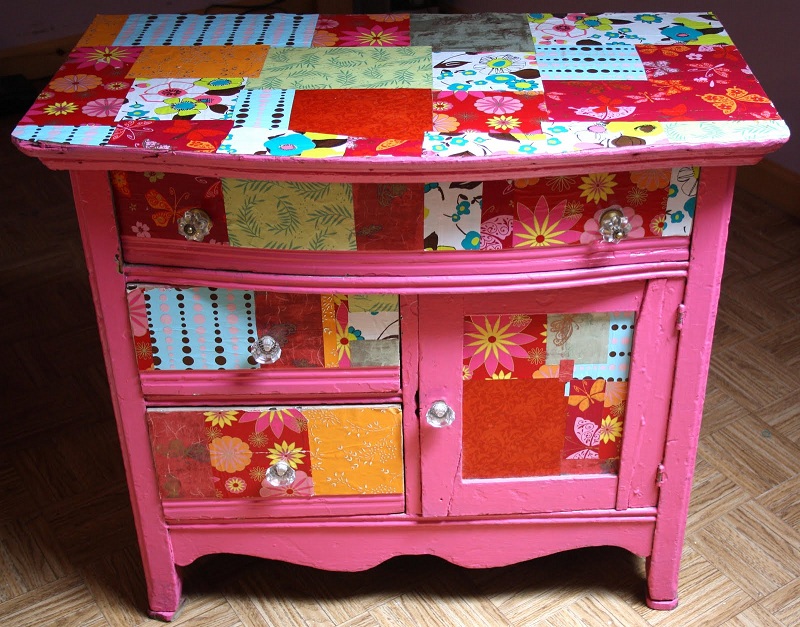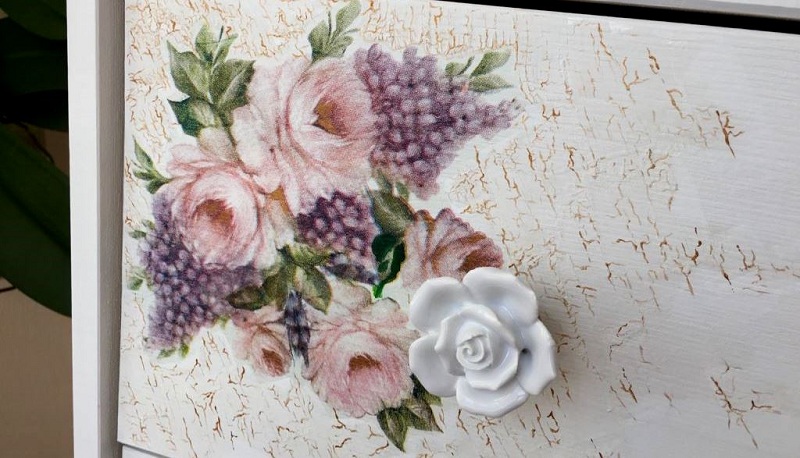The technique of decoupage is known from time immemorial; even in the Middle Ages, Venetian masters successfully mastered it, having adopted the art of decorating furniture with carved images from Chinese colleagues. Nowadays, decoupage is associated with interiors in the style of Provence, Chebbi-chic, with palace interiors in the spirit of Baroque, Rococo, with a classic design. It is caused by the fact that the technique is used to update old furniture or to give the new items of furniture the effect of aging. In both cases, chairs, sideboards, coffee tables, dressers, wardrobes, and stools acquire individuality, and sometimes a new life.

Types of decoupage
The basic principle of decoupage is the pasting of the prepared surface with different materials, followed by varnishing. However, this technique has several subspecies. Some of them require certain skills, others are completely accessible to beginners who want to restore or simply decorate the furniture with their own hands. As finishing decorative materials use:
- wallpaper;
- the cloth;
- napkins and decoupage cards;
- pictures printed on a regular or 3D printer, clippings from magazines, newspapers (as in the photo below).

The process of decoupage furniture wallpaper
Regardless of the chosen technique and method of decoupage, the surface must first be prepared by walking on it with a grinding machine or sandpaper. This is done in order to remove the paint and varnish during the restoration of old furniture. If necessary, use a solvent. Cracks and chips are processed by putty. If you plan to create a collage of pieces of different wallpaper with gaps, you should apply paint for the background on the prepared surface.
If you plan to glue large areas, the front parts of the drawers of the dresser, table tops, the inner wall of the rack, you can do without paint. Wallpaper glued to wallpaper paste, carefully smoothed with a roller or a clean cloth, starting from the center towards the edges. After the glue has completely dried, several layers of lacquer can be applied to the wallpaper.
You can update the coffee table with your own hands without using acrylic: just cut a suitable piece of wallpaper and put it on the tabletop, and then cover it with glass. This option is suitable for those who have not yet mastered the skill of decoupage or are not sure of the correctness of the decision. If desired, the table can quickly return the original appearance.
How to make decoupage cloth with your own hands?
Since the fabric is very different in structure and other characteristics from paper, updating the cupboards and chest of drawers with the help of pieces of fabric requires a special approach. It is necessary to carefully consider the future composition, arrange the scraps by colors and prints so that the final picture looks harmonious, rather than coarse and well fit into the interior of the room.
Updating a table, dresser or cabinet begins with the removal of old paint with a solvent. Then the surface is ground, flattened, primed or painted. PVA glue is applied to the furniture, and the fabric pieces are soaked with special glue for decoupage and neatly glued to pre-marked areas. The fabric is repeatedly processed with glue from a spray bottle, and then the future masterpiece is allowed to dry and covered with 3-4 layers of acrylic varnish.
An alternative to decoupage with the help of fabric is stenciled staining of old furniture. In this case, instead of a stencil, you can use old lace, tulle, and other openwork materials.

Decoupage technique with napkins and special cards
The process of decorating with napkins or cards is simple and suitable for beginners. Classical methods of restoring old and personalizing new furniture are used to process dishes, glass surfaces, various containers (boxes, boxes), decorate cards, Easter eggs, and handmade accessories.
You can use multi-layered napkins with pictures or professional cards for decoupage. Napkins are divided into layers, choose the layer on which the image is applied. The pictures are cut with nail scissors or pulled out manually (the process is much faster if you have cards in your hands) and applied to the prepared surface (wood, cardboard, metal, plywood, chipboard), after processing with white glue. The drawings are smoothed with a brush, roller or dry clean cloth, dried and applied varnish (when decorating Easter eggs it is recommended to use egg yolk).
The process of decoupage furniture with newspaper clippings, printouts of pictures and plots (the latter are best done on thin copy paper) is similar to the decoration with napkins and special cards.

Some techniques and types of decoupage
For the entire time of the existence of the skill of decorating surfaces with glued patterns, the following types of decoupage appeared:
- classical;
- volume;
- smoky or artistic;
- back;
- Dekopatch.
Classic decoupage involves applying to the surface of furniture in a dry, wet or hot way napkins or cards with drawings. After the glue dries, the picture can be tinted, give different effects, and then coated with acrylic varnish.
Volumetric decoupage is performed using stencils and drawings printed on a 3D printer, napkins, fabrics, various additional materials (modeling pastes, gels, putties, paints). The depth effect reaches the drawing of the background and shadows and requires a high level of artistic skill from the performer.

Artistic decoupage also involves the use of special colors for the background and the processing of the pattern itself. The surface of the furniture is painted in several tones, the colors are mixed to make the image vague, blurry, and airy. This technique is called smoky not without reason, since mixing pastels and acrylic paints create the effect of a real picture with a deep background as if filled with clouds of colored smoke.
Reverse decoupage differs from the classical sequence of actions: a drawing is applied on a transparent surface, and then the glass is primed and varnished. In this way, the transparent doors of kitchen cabinets, sideboards, decorative dishes are updated.

Tandem patchwork and decoupage techniques. Pieces of special paper imitating stone, fur, fabric, other textures, and materials, as well as old newspapers are glued close to each other or overlapped, creating a picture-background with stunning effects. After the glue dries, the decor is painted.

Artistic processing with different effects
For craftsmen who have mastered various methods of renovation and restoration with their own hands, it will be interesting to learn how to make tables, cabinets and cribs even more elegant and refined. So, the following artistic processing methods are combined with the decoration in the decoupage technique:
- toning (applying layers of color paint to give the pictures a special shade);
- patinating (imitation of the thing “with history” with the help of black, color, dark patina on the corners, edges, places of contact with human hands);
- aging (artificial creation of scuffs, retro-effect through wax and sandpaper);
- gilding (gold, silver and bronze paint on the pattern, giving the luxurious and exclusive look to the piece of furniture);
- craquelure (creates the effect of the cracked coating from time to time, for which a special varnish is applied on the top or between two layers of paint).

Master class on decoupage furniture for beginners
Decoupage is a universal technique available even to unprepared beginners. With the help of simple tricks, you will be able to renovate furniture with your own hands, disguise small defects, give a special chic and flavor to inconspicuous and faceless furnishings, even if it is new. For decoration, you can choose any drawings and motifs, which will make the table or wardrobe using decoupage technique an organic element of the interior in the style of modern, Provence, retro, classic, ethnic, country, modern or oriental apartment design. It is recommended to start mastering the technique with the simplest method of decoration using napkins.

Materials and tools
To decorate wooden furniture with napkins you will need the following accessories:
- napkins themselves or pictures printed on the printer;
- scissors with sharp blades (special, manicure or medical) and a sharp scalpel (for applications of thick paper);
- glue (PVA, wallpaper, egg white or special for decoupage);
- acrylic lacquer;
- putty or primer;
- acrylic paints, pastels, tinting paints for the background;
- brushes (for glue, varnish, paints);
- solvent, sanding machine and sandpaper for surface preparation;
- sponge, napkin or roller to smooth the pattern.

Step-by-step instruction
The master class for decoupage a cabinet door or a wooden tabletop includes the following steps:
- Surface treatment with a solvent (removal of old paint), sanding (removing varnish, irregularities).
- Applying a primer or putty for leveling the background, wax fills cracks and chips.
- At will, the surface is painted in a pre-selected shade with acrylic paint (it is better to choose a light tone since the translucent napkin will be invisible against a dark background).
- Separate the top layer with a napkin from a napkin, it is cut out with scissors or pulled out with hands.
- Glue can be applied in two ways: on the surface of furniture or on a napkin from the wrong side. In any case, the picture is impregnated with glue and then carefully smoothed with a brush, roller.
- After the glue dries, apply acrylic lacquer in 3-4 layers with intermediate drying. For the first experience, it is better to choose an aerosol can.

Decoupage is good because this technique can be improved, each time bringing new creative ideas to the process and getting unusual visual effects. Any subjects, plots, style, – applications on furniture will help to realize the most courageous imaginations at the minimum expenses.

